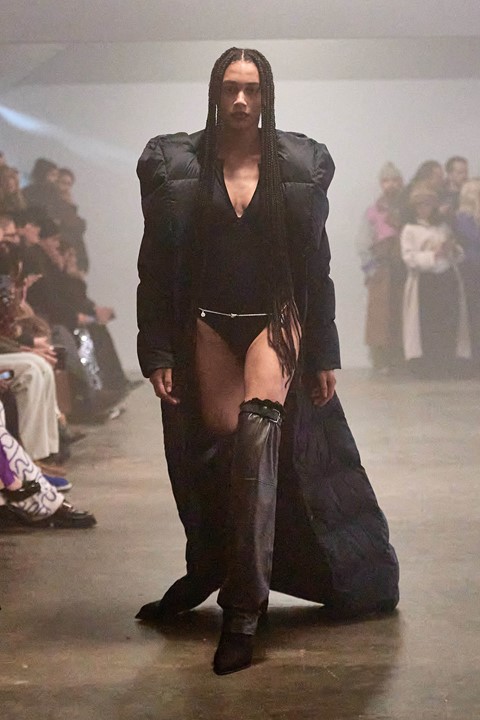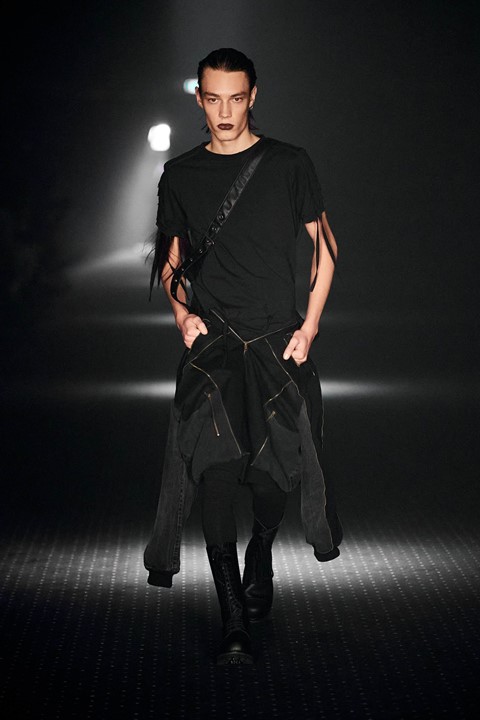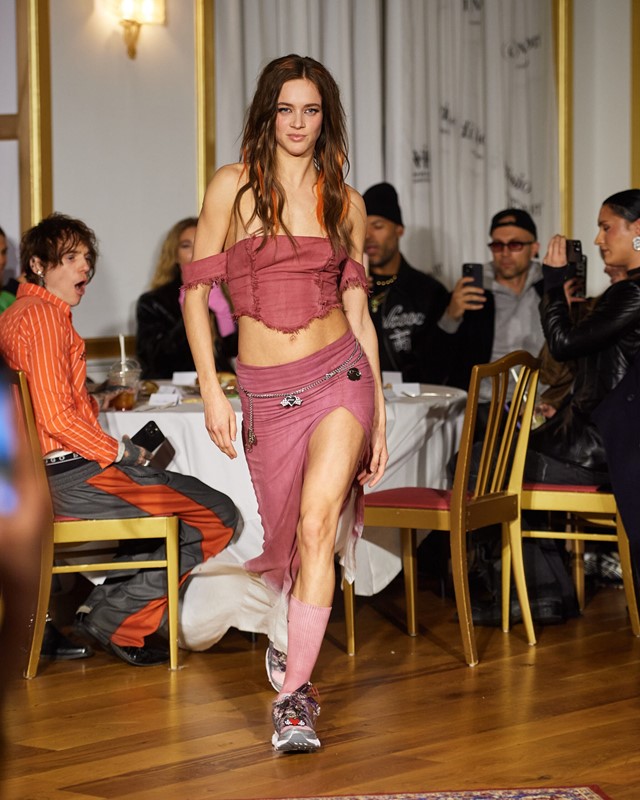“I see it as a third wave of Scandi chic”: Once known for its pared-back, polished aesthetic, this season Copenhagen Fashion Week showed that something darker and more disruptive is bubbling up among the city’s designers
As the biggest event on the Nordic fashion calendar, Copenhagen Fashion Week often sets the tone for what’s to come in the region. Historically synonymous with minimalism, brands like Ganni and Stine Goya have achieved global renown for introducing the vivacious use of colour and print. “We’ve been known for this Scandi minimalism where everything had to be so clean and all beige,” says Danish freelance stylist, Søren Kolborg Sørensen. “Then, the Ganni Girl look went worldwide, which was about brave colour combos – it had to be easy and on the go, where you could just hop on your bike and ride around the city.” This season, it was clear that a marked shift is underway – “I see it as a third wave of Scandi chic,” says Sørensen. Clean silhouettes and block colours are being traded in for an aesthetic that’s darker and more disruptive: gone is the polished, pared-back aesthetic, a new look is in town and it’s decidedly rough around the edges.
This week a TikTok went viral that features a model standing up to raise a toast before sweeping out of the room – a tablecloth covered in plates, glasses, food and drink, surreptitiously attached to her dress, cascading down behind her. This was the finale of (di)vision’s A/W23 show. Founded in 2018 by brother-and-sister duo Simon and Nanna Wick, this brand is quickly garnering attention for its attitude-fuelled approach to design. Widely known for their two-tone split bomber jacket, the pair channel an old-school vibe, dripping with teenage nostalgia – think graphic-print tees, low-rise shorts and slouch-fit jeans covered in patches. “I remember when we started, we were asked: ‘What’s Danish about you? What’s Scandi?’ But come to think of it, there’s not much that’s Scandi about it,” explains Simon. With theatrical storytelling a key component of their brand identity, the pair actively veer away from minimalism as much as possible. “We’re building something for our generation,” he continues. “We don’t wear minimalistic stuff and like to express ourselves in a given way, and I think that’s relatable for a lot of young people. There’s a rebellious aspect to it.”
@voguefrance Attention please! 🍷@sarahdarliing au show @di_vsn à la Fashion Week de Copenhague. #FashionTikTok #CFW #copenhagenfashionweek ♬ son original - Vogue France
This season, (di)vision’s guests sat around ornate dining tables at the historic hotel restaurant, Josty. Greeted by piles of half-eaten plates and red-wine-stained tablecloths, a jazz band treated the crowd to renditions of classic 90s/00s hits from the likes of the Red Hot Chilli Peppers and Linkin Park. The siblings’ cast of friends, which included a mixed bag of models, skaters and artists, walked through the space – purposefully on their worst behaviour – dressed in outfits of distressed denim, camo skater shorts and splatter-dyed crop tops.
“The whole theme we dived into started with me watching the Woodstock ‘99 documentary,” says Simon, who grew up on a diet of American pop culture, and references a UFO report from the Pentagon and the 1979 film Apocalypse Now as previous sources of inspiration. He explains that (di)vision is centred around instances of contrast, so the idea was to present their collection in a space that represented the total inverse of the chaotic festival – naturally, New York’s annual Met Gala. Equal parts glitz and grunge, the show encapsulated the label’s outlook: “To be disruptive, in some way, is why we began,” he says.

While subculture and left-field pop cultural moments influenced some of this season’s designers, others took a more abstract approach and reached the same nonconformist conclusion. Vetements alumnus Peter Lundvald Nielsen is the creative director and head designer of PLN, which made its Copenhagen Fashion Week debut last season. “I was surprised I got selected,” he says. “I wanted it, but they really took a chance [on PLN] because we offer something so different from the rest of the schedule.” Specialising in dark, distressed pieces in an array of volumes, Nielsen looks to the body for inspiration. “It’s not only about what people are wearing from the punk, skate or goth scene; it’s more about the silhouettes,” he explains. “It’s about what people wear and how they wear things: how pieces hang on the body. [We specifically] look at the contrast between big silhouettes and more form-fitting pieces.”
The brand’s show took place at the Bella Centre: a large, square space submerged in darkness; a delicate mist hung in the air. “It was very dark, so some people were like, ‘Oh, you can’t really see the clothes that well,’ but it’s about taking what you want to take away from it,” he says. The designer explains that the label intends to create an intuitive universe, where people are encouraged to wear PLN’s designs in their own way. Nielsen’s also aware that he’s not alone in his vision: “There are so many emerging designers here that have a very different take on what Copenhagen used to represent, a lot of [us] want to start something new.”
But what happens when an older, more commercial brand wants to get in on the action? Established back in 2002, Wood Wood has always called on underground subcultures to dictate its path. Recently, Cecilie Engberg and Dominic Huckbody have joined to head up the design team, having worked at Balenciaga and Martine Rose, respectively. For this season’s show, the team constructed a makeshift club at Simian gallery to echo the energy that a night out has to offer: a safe space to connect. “It wasn’t about working with stereotypical clubbing elements but more with the sentiment of freedom – dancing on your own or with a crowd,” Engberg explains, as the duo looked to Copenhagen’s current youth culture to shape their collection.

“As an outsider from the UK, it’s been interesting to see the different ways in which Copenhagen’s young people metabolise clothing,” explains Huckbody. “All of the pieces that they wear are in many ways pedestrian, but the way in which they combine them is very personal, so people start to look more like characters.” As models stepped out in denim dyed in club-light hues and oversized jackets fused with technical hoodies, it was clear that the designers are game to allow the city’s experimental youth to set the brand’s new agenda.
In 2017, The Business of Fashion published an article titled: “Is the ‘Copenhagen Girl’ Denmark’s Next Big Export?” Seen as an ultra-feminine evolution of the classic, minimal look that Scandinavia pioneered, the fashion week calendar is rife with labels like Saks Potts and Remain that have honed this aesthetic and found great success. While prim and proper undoubtedly has its place, Copenhagen today is filled with brands wanting to do something different. “We’re definitely moving into this new era that’s been inspired by international houses but with a Danish spin,” says Kolborg Sørensen. “Looking into PLN and Wood Wood, with designers coming from Vetements and Balenciaga, they’re extending worldwide trends; It’s more liberated and free-spirited.” Designers across the board are rejecting convention and operating with an unapologetic frame of mind, or as Nielsen puts it: “I am who I am and I like what I like.”
